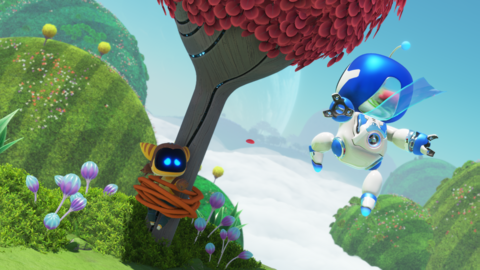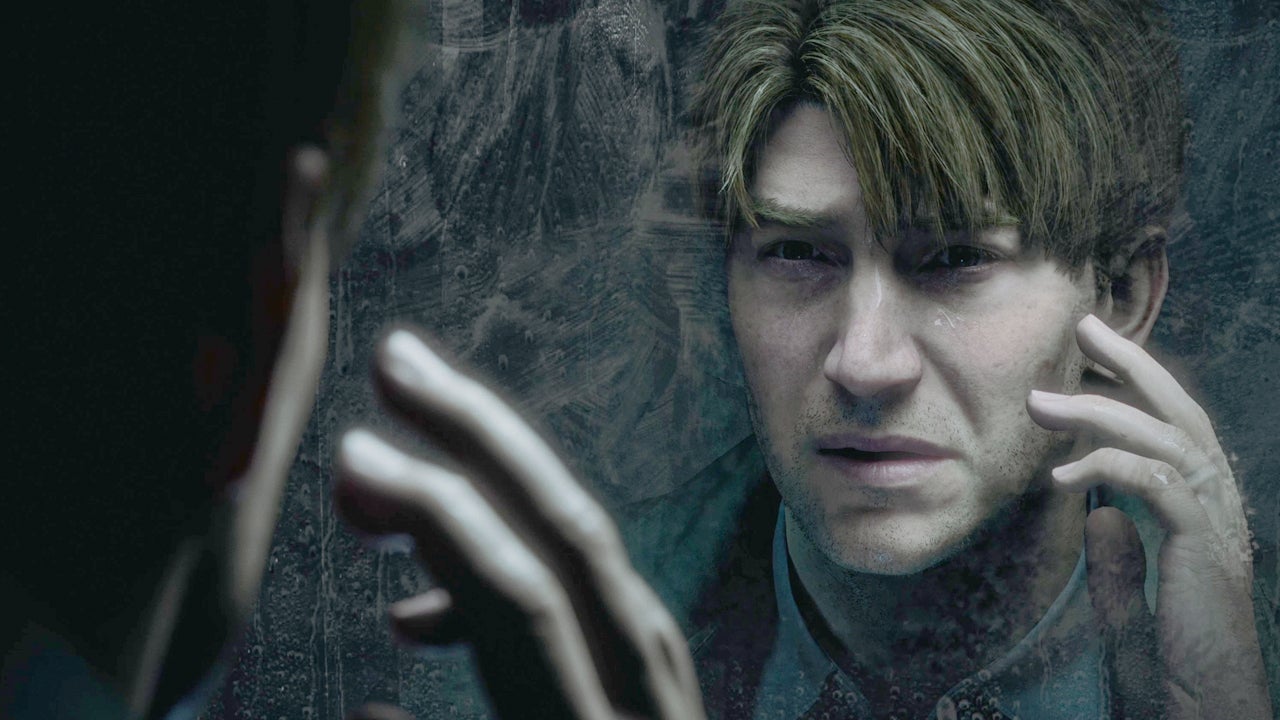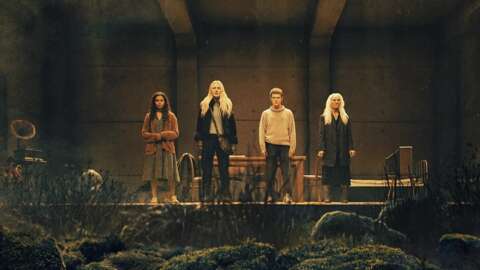What’s it like to be trapped in a hell of your own making? For writer Alan Wake, that’s the story he’s trying to tell. And after watching a full 40-minute demo, played from the perspective of Wake himself, it certainly looks set to be a tale worth telling. Taking place in an area called The Dark Place, this lengthy slice of the story follows Alan as he makes his way through an oppressive and haunting replica of New York City riddled with danger, gunfights, and puzzles. It’s classic survival horror but with the distinct edge of developer Remedy - smart, engrossing, and consistently odd.
First things first, it's difficult to overstate just how visually striking The Dark Place is. Roads are populated by levitating, oil spill-like pools of darkness that glisten and contort as you move through them. Newspapers litter the streets, sticking to their remarkably detailed asphalt as Se7en-level amounts of rain crashes down. It's a truly stunning nightmare rendering of New York that not only impresses in its scope and monstrous nature (this is a significantly more detailed and expansive environment than anything in the original game) but also feels convincingly claustrophobic when in its dark and deadly alleyways. While not huge in terms of pure square footage, the city block winds and connects in unexpected ways, representative of its unreliable narrator who quite literally writes in new sections of architecture as he presses onward.
A world apart from the small town, Twin Peaks-inspired Bright Falls setting of the other half of Alan Wake 2’s story, these mean streets owe more to Martin Scorsese than David Lynch. The 1970s Taxi Driver-influenced colour palette bursts out the screen. Red and green neon lights slice through the darkness and bounce off of puddles, reflecting Wake's troubled and vivid imagination. An imagination that bleeds into the alleyways of The Dark Place without invitation. Easter eggs appear at every turn in classic Remedy fashion: Night Springs billboards, graffiti acting as ghosts of his haunted past, and the ominous Caldera Street Station - a clever bilingual nod to his Cauldron Lake prison.
But those Easter eggs are not always in the background. A standout moment in the demo comes as the titular detective of Alan's Alex Casey novels confronting his creator in a smog-filled alley. Casey wears the face of Remedy’s own creative director, Sam Lake, who dusts off a familiar paisley-patterned tie and weathered leather jacket to max effect. He echoes Remedy's past by shaping Wake's future. The meta levels of Remedy’s unique approach reach winking new highs here as James McCaffrey’s scratchy voice performance transports me back to bullet time ballets once danced. The passing of the torch from one very different hero to another comes in the form of a common object between the two, however, as the cold metal of a revolver feels more like a warm friend.
The combat navigated with it appears fundamentally similar to that fought by Alan Wake 2's other protagonist, Saga. Alan uses a flashlight to burn away the dark armoured cloud shielding his enemies, before filling their slightly more human form with bullet after bullet. There's an uncertainty as to which of the many shadows haunting the streets will actually be hostile, though. This seems to add an extra level of tension to every step; a moment of hesitation before the precious flashlight battery life is potentially wasted on nothing more than a dark shape. It's edge-of-your-seat stuff and yet another example of the sequel's descent into full horror.
It's made all the more exciting by the infrequency of these encounters and just how many shots enemies look like they can take. It seems that even the most simple-appearing of fights could be a challenge. The developers have talked of their desire to move away from the wave-based flooding that the 2010 original indulged in, and it looks to only be for the betterment of the sequel. Despite not lacking in action, it's hard to call Alan Wake 2 an ‘action game’ from what I've seen so far. It appears much more interested in testing your problem-solving abilities - some of which will involve weaponry - but all in service of unraveling its story and unlocking the horrors it's hiding.
Outside of combat, environmental puzzles take centre stage. Ferrying light through shadowed streets reveals new opportunities and grants fresh paths of progress through the city and its story. You’ll do this by absorbing energy from nearby light sources into your handy Angel Lamp and unloading it into unpowered bulbs and streetlights. These newly brightened areas are immediately warped into something new; a shadowy garbage heap suddenly becomes an illuminated subway entrance, for example. It's reminiscent of masterpieces of level design like Dishonored 2's Crack in the Slab or Titanfall 2's Effect and Cause, albeit more focused in scale rather than level-wide shifting realities.
If the glimpses of gameplay we've seen from the Saga side look more inspired by the original Alan Wake and recent Resident Evil remakes, this Dark Place mission seems to owe much more to the warping weirdness of Control. As briefly mentioned previously, Alan is able to change the layout of the city as he goes - it's a place of his own dark creation, after all. For example, after venturing down into the dead end of a subway station, Alan sees visions of Detective Casey investigating a case. It’s a source of inspiration; a creative spark that writes a new path. Where a wall once stood, an open tunnel now beckons. It's an intelligent design decision that not only wows visually but crucially fits Wake as a character - a tortured writer looking to type his way out of the hell of his creating.
When these points of inspiration for his latest novel are discovered, you’re notified that a new plot is available to use. From here you can enter Alan's writer's room, a sort of 3D menu that manifests as a log cabin complete with a typewriter and a chalkboard ready to be filled with ideas. It’s on that board that you can recap what has been learned so far, and — more crucially — decide where the story goes next. As Alan descends deeper into the tunnels below the city, he is able to remix and rewrite certain locations to give different contexts to objects in the world.
For example, Alan discovers a derailed train that blocks his path. But, using information from a previously discovered source of inspiration, he’s able to re-write the scene to open the train and provide a path onward. But this new storyline paints over the train with the symbols of a terrifying murder cult and fills its seats with the horrifying, burnt remains of commuters who were cooked alive. Their long-since-screamed cries pierce through the haunting sound mix.
I don’t want to reveal too much of what’s going on here story-wise, and truth be told some of it is so cryptic and bizarre that I couldn’t even begin to guess where it could go next. Stacked walls of TVs broadcast a late-night talk show. Disconnected voices whisper advice and shout warnings. Quantum Break’s Shawn Ashmore even pops us as somebody called Tim Breaker, a mysterious man in a police uniform looking to help Alan.
It’s layered, dense, and written with the same pulpy yet poetic flourishes that you’d expect from Remedy ever since Max Payne’s noir-drenched comic book panels. This is one Dark Place where subtext definitely isn’t for cowards. Yet despite that pulp, the words are all convincingly performed, with voice actor Matthew Porretta conveying the fear of the situation Alan finds himself in just as brilliantly as Ilkka Villi — who provides Alan’s physical form — does through his eyes.
As the chapter progresses, the Dark Place opens up and reveals what appears to be a Metroid-like nature. Lessons seem to have been learned from Control here as useful shortcuts are created, secrets discovered, and optional puzzles discovered that you’re welcome to return to later. From what I understand, this slice of New York isn’t a map you’ll visit once for a mission and never see again, but a hub you’ll revisit time and time again across the length of Alan’s side of this ambitious sequel’s story.
Alan Wake 2 looks to be bottling up what I love about the original and mixing it with some of the newest tricks Remedy has added to their repertoire post-Control. I truthfully don’t know if I’ve seen many better-looking games before; a genuine graphical and artistic powerhouse with a powerfully odd and oppressive tone to match. And while it may be survival horror, don’t go in expecting a bloodfest. This is a much more cerebral approach to the genre and one I couldn’t be more encouraged by. Alan Wake may be living in a hell of his own design, but it looks like I might soon be playing in a heaven of Remedy’s making.
Simon Cardy frequently goes to a dark place. Follow him on Twitter at @CardySimon.






